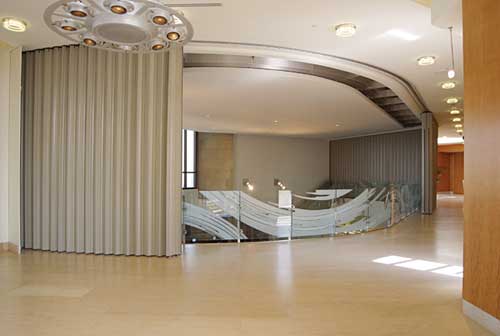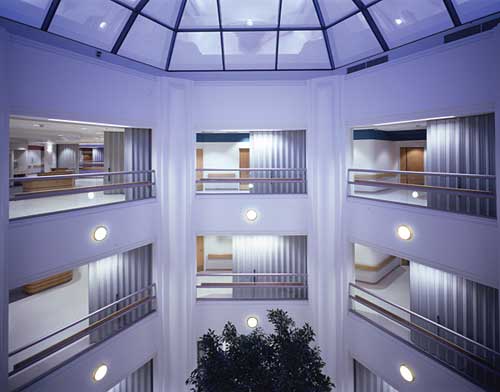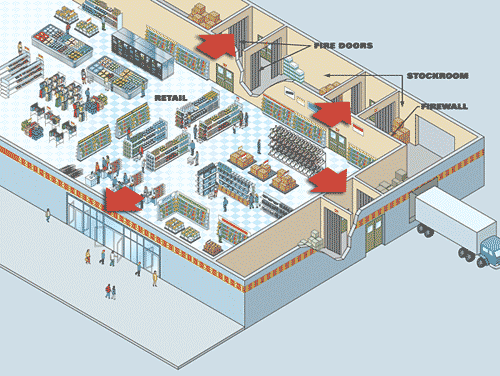Horizontal Sliding Fire Doors: Catalyst for Architectural Versatility
Concealed sliding fire-rated door systems that can also seal off sections to separate occupants are an ideal solution in airports whose business is moving many thousands of travelers quickly. The addition of the International Terminal at Baltimore/Washington International Airport required an area separation between the new and old terminal. RTKL of Baltimore, which provided a package of regionally sensitive graphic materials and a comprehensive set of tenant criteria, protected the wide span openings with a sliding fire door. The door assembly allows an unobstructed flow of airport traffic by remaining in the open position and yet having the capability to automatically close when the building fire alarm system is activated. Sliding fire door systems are also found in Orlando International Airport, Charlotte Douglas, Newark, San Diego, Ronald Reagan Washington International and many other airports.
 |
Invisibly hidden in pocket doors when open, a curved sliding door offers Photo courtesy of Promotional Design Associates |
Â
Inspired by the Bilbao Guggenheim Museum, the 42,000 sq ft Cerritos Library addition by CWA AIA, Inc. of Glendale, CA, is a library of the future. With three floors wrapped in a skin of titanium that allows fluid compound curve ? the building is the first titanium-clad structure in the U.S.? it contains 1,200 internet ports, hundreds of computer workstations plus a 15,000 gallon saltwater aquarium. A wide span curving sliding fire door system provides invisible protection for the interior stairways. With no floor track, a sliding door system provides invisible vertical separation of the third floor.
Expansions and renovations to historic buildings invariably involve solving code requirements relating to stairwells, staircases and issues arising from combining the old with the new. Concealed curved sliding fire doors will provide vertical separation, protect staircases and maintain openness.
MJSA Architects of Salt Lake City, UT, built a semi-circular clerestory to join the renovated 1892 historic Provo City Library, Provo, UT, to a large modern library addition. Since the aggregate square footage exceeded the allowable area defined in the current code, a 2-hour fire barrier was required to separate a large portion of the historic renovation. A horizontal sliding fire door assembly was installed at the junction of one end of the clerestory. "We couldn't have had such a wide span opening," says Christiane Phillips, AIA, who was involved with the project. "We would have had to put in two sets of side hinged swing doors plus some kind of a fixed wall."
Interior atria design with large openings that allow interior spaces to receive daylight, presents a special challenge for health care facilities because code requirements require a 2-hour fire rated separation between floors. The Jewish Home for the Aged in San Francisco, known for investing in environmental design research for its interiors and gardens in order to enhance residents' lives, is an example of complying with code requirements while achieving a rare trio of daylight-filled linked atria.
Designed by RBB Architects of Los Angeles, the three-story, 110,000 sq-ft, 120-bed skilled nursing facility was designed and planned with expanded floor area for the patients, more amenities, and less of an institutional ambiance. A typical residential floor is designed in an intersecting three-circle configuration. Each circle is surrounded by residential rooms and contains a sky lit atrium landscaped with large trees and ornamental plants that are visible from all levels of each circular module. At the intersection of each of these circles is a nurse's station. This floor plan provides a clear view of all entrances to rooms and corridors. A spacious pathway around the atrium leads to the residents' rooms and is designed to invite people to congregate in small groups for social interaction, while still being within view of the nurses' station.
In order to meet 2-hour fire code requirements, RBB specified horizontal sliding doors on each floor at every opening inside the atria that, when closed, would comply with fire code requirements for fire separation between floors. Sliding doors also complied with egress and access needs. "We did not want motel-like corridors where people were separated and there is no connection from floor to floor," says Deneys Purcell, President, RBB. "We wanted to replicate a little courtyard where people could see their neighbor downstairs and have a sense of overall community." Without firerated horizontal sliding doors, he adds, the firm could not have used the atria design and they would have been forced to separate each floor "like a hotel or motel."
 |
Without concealed 2-hour fire-rated sliding doors to separate floors, residents in this senior adults home would not be able to look inside the atrium. Photo courtesy of Won-Door Products |
Â
Providing egress in retail venues can be a challenge, particularly in high volume turnover stores where stock is stored on the perimeter. At a major retailer, stockroom size is minimized so that the majority of floor space can be devoted to the retail sales floor. Shipments arrive daily and are staged around the perimeter. This configuration presents problems if customers and employees need to leave the building quickly in a fire emergency. Building codes state that the number of exits, travel distance between exits and exit spacing must be based on the square footage and occupancy loads of the building. To meet these requirements, it was necessary that the doors leading from the retail sales space to the stockroom be used as a means of egress ? requiring passage through different types of occupancies. In addition, these exiting corridors needed to be separated from their adjoining areas, often requiring a large span fire-rated barrier. Traditional fire doors would have limited the size of opening, required multiple sets of doors and increased maintenance costs.
Instead, sliding fire door systems could be used to separate existing corridors from the stockroom. They had the advantage when open, of allowing unobstructed access to all areas of the loading docks, stockroom and retail space. They also met code requirements for use as a means of egress without occupant load limitations. Specifying sliding door systems can be accomplished at a price comparable to or less than traditional swinging fire door assemblies. Prices are not competitive, however, for assemblies fitting small openings.
 |
In an emergency, sliding doors create corridors from retail spaces through the stockrooms so that shoppers and employees can safely exit. Image courtesy of Steve Stankiewicz |









